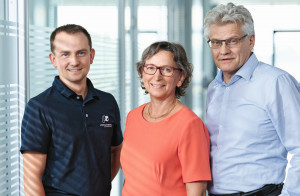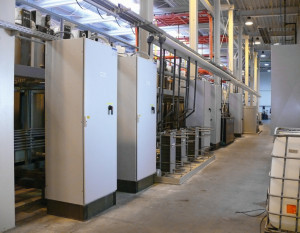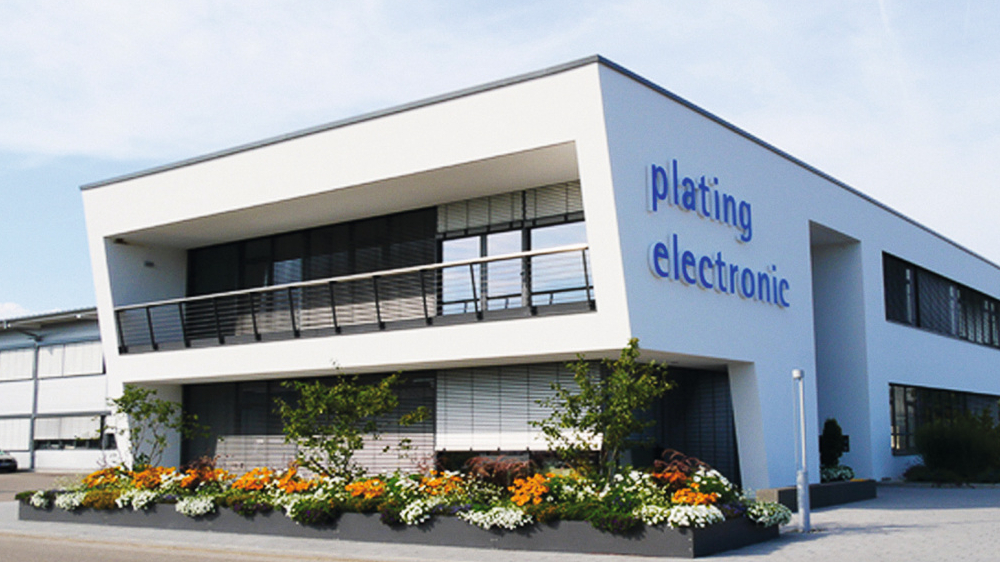In 35 years from a start-up to an important 100-man medium-sized company. In this interview, Karl and Sebastian Rieder talk about the potential applications of their technology, international business and the development of plating electronic.
The rectifier experts from Sexau at the foot of the Black Forest have experienced a continuous upswing since their foundation 35 years ago. Today, the family-run company is one of the drivers of innovation in direct current and pulsed current sources for electrochemical processes in industry and research. For this reason, plating electronic could not be missing at the Surface Technology trade fair for electroplating and surface technology in Stuttgart. Galvanotechnik" took the opportunity for a lengthy discussion with Managing Director Karl Rieder and his son Sebastian Rieder, who is also developing new business areas beyond electrochemistry.
What significance does electroplating and surface technology have for your business?
 Karl and Sebastian Rieder at Surface Technology in June. Plating electronic is also active internationally Karl Rieder: You can tell from the name. Since the company was founded, the focus has been on the electroplating industry as a customer base. And even if I look to the future, in which resource conservation will play a greater role, electroplating technology has a future. But we also want to grow to a certain extent, we want to make optimum use of our resources and development capacities. That is why we are always looking left and right to see how our devices, which we originally developed for electroplating, can be used in other markets, and we will continue to play a leading role in the electroplating industry with our products.
Karl and Sebastian Rieder at Surface Technology in June. Plating electronic is also active internationally Karl Rieder: You can tell from the name. Since the company was founded, the focus has been on the electroplating industry as a customer base. And even if I look to the future, in which resource conservation will play a greater role, electroplating technology has a future. But we also want to grow to a certain extent, we want to make optimum use of our resources and development capacities. That is why we are always looking left and right to see how our devices, which we originally developed for electroplating, can be used in other markets, and we will continue to play a leading role in the electroplating industry with our products.
Which of your devices are most commonly found in electroplating shops?
When we started 35 years ago, we relied on switching power supply technology right from the start. This technology has become very well established and is now the driving technology in our field. It also enables us to meet current requirements, as switching power supply technology greatly improves the energy efficiency of devices. The semiconductor market is also playing into our hands here, as there are increasingly efficient products that increase the efficiency of our devices and systems, such as SiC-MOS technology, which is now also being used in e-mobility.
So your devices are continuously becoming more energy efficient?
Yes, we also see further potential here. Our new products are being continuously developed in this area.
You are the technology leader in direct and pulsed current sources for electrochemical processes. Which customer sectors do you serve with your products?
There is a wide range of applications. One major area of application is PCB production, especially high-density interconnect (HDI) PCBs, which make very intensive use of pulse technology for production. Then there is automotive construction in various forms, corrosion protection and cathodic dip coating (CDC). Another large area is conveyor systems for the production of connectors and dental drills, which are coated throughout Europe with the help of our rectifiers. Our power sources are also installed in anodizing systems, and we also have hard chrome customers and supply our systems to many other sectors, e.g. aerospace, watchmaking and jewelry manufacturing. Our customers reflect the entire spectrum of surface treatment.
The systems can also be used in the areas of Power-to-X, i.e. the storage of surplus electricity and renewable energies. Is that going well?
Sebastian Rieder: This business area is still being developed. But it is going well. We have already delivered rectifiers for pilot plants for hydrogen filling stations. Our power sources are also used in container systems to temporarily store surplus energy from wind farms. There are also customers from the chemical industry who use our devices to produce hydrogen as a process gas.
Are you also doing something for your own carbon footprint and energy consumption?
 The company, which was founded in 1987, is managed by Karl Rieder (right). Almost the entire family is now involved. Also in the picture: wife Dorothea and son Sebastian We use modern, regenerative loads to keep energy consumption in production low. We have always invested a lot in this area in recent years. In 2021, for example, we installed a photovoltaic system on our production building so that we can generate as much of the electricity we need for testing and production as possible ourselves.
The company, which was founded in 1987, is managed by Karl Rieder (right). Almost the entire family is now involved. Also in the picture: wife Dorothea and son Sebastian We use modern, regenerative loads to keep energy consumption in production low. We have always invested a lot in this area in recent years. In 2021, for example, we installed a photovoltaic system on our production building so that we can generate as much of the electricity we need for testing and production as possible ourselves.
You employ around 100 people and are active in Europe, America, Asia and Australia. There is now a war in Ukraine and the energy and metal markets are characterized by price fluctuations and supply difficulties. How do you assess the development and the impact on your business?
Karl Rieder: I don't believe in the deglobalization that some people are talking about. Germany is dependent on the global market. But there are political developments that influence international business. Just think of China, which has bought a lot of technology abroad. This is increasingly politically undesirable, which is why I expect business in China to decline in the medium term. However, we will continue to operate internationally because our customers are and because we follow them. There is a demand for service, so we will maintain our after-sales business in the long term.
The order situation in the electroplating industry is currently very good. Is this also affecting your business?
At the moment it is. We have already been through one or two crises with our customers. But the mood is good at the moment, as you can see here at the trade fair.
Could you briefly outline how your company started out?
 Switch cabinets from plating electronic in an electroplating shopWestarted out in the garage or basement, so to speak. At the time the company was founded in 1987, switching power supply technology was just emerging. It was still new in electroplating and surface technology. And since the location of our company was not too far from the gold town of Pforzheim with its numerous electroplating shops, we were able to convince a few companies there of our technology as a first step. Our advantage was that we were able to offer smaller companies very precise rectifiers for minimum plating. This enabled them to meet their customers' requirements without using too much material. This worked quite well, especially for gold and silver. It takes a certain amount of time to deposit a few micrometers of metal. The more accurate the device is, the more precise the deposition can be set and that saves gold. That's how our business got off the ground. And here we are today. We then experienced a continuous rise. We now have many employees who have been with us for more than 20 years.
Switch cabinets from plating electronic in an electroplating shopWestarted out in the garage or basement, so to speak. At the time the company was founded in 1987, switching power supply technology was just emerging. It was still new in electroplating and surface technology. And since the location of our company was not too far from the gold town of Pforzheim with its numerous electroplating shops, we were able to convince a few companies there of our technology as a first step. Our advantage was that we were able to offer smaller companies very precise rectifiers for minimum plating. This enabled them to meet their customers' requirements without using too much material. This worked quite well, especially for gold and silver. It takes a certain amount of time to deposit a few micrometers of metal. The more accurate the device is, the more precise the deposition can be set and that saves gold. That's how our business got off the ground. And here we are today. We then experienced a continuous rise. We now have many employees who have been with us for more than 20 years.
How are the tasks in your company divided up?
Karl Rieder: We are all involved in the company, my wife, my three sons and myself.
Sebastian Rieder: We are active in different areas. I work in sales and build up new business areas. The middle brother has been working in production for a year and the youngest brother is just finishing his studies and wants to join the company afterwards.
Karl Rieder: He trained as an electronics technician with us and knows the company inside out. My wife has also been working in the company for over 20 years and is responsible for HR and accounting. I am now more involved in development management and less in sales activities.
When you look to the future after 35 years of company history. What is the outlook?
In the past, our business has grown continuously and we have regularly adapted our products. In the coming years, however, we will face many challenges, particularly the upheaval in the economy with the energy transition and the move towards e-mobility. However, we are well positioned with our product portfolio. Our workforce of around 100 employees includes 14 developers alone - electrical engineers and software developers - with whom we believe we are well equipped for the future.
INFO
plating electronic: innovation driver for industrial power supplies
- 1987: Company founded in Emmendingen near Freiburg
- 1993: Relocation to Denzlingen near Freiburg
- 2016: Move to the new company building with administration and production in Sexau near Freiburg
- 2021: Commissioning of the modern photovoltaic system with 265 kW peak output, building heating through CHP
- 2021: Device testing with regenerative water-cooled loads up to 400 kW
- 2022 Installation of e-charging stations for e-car fleet


